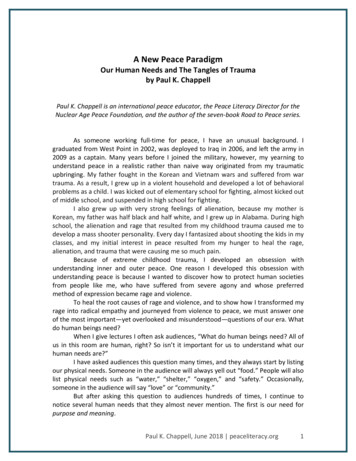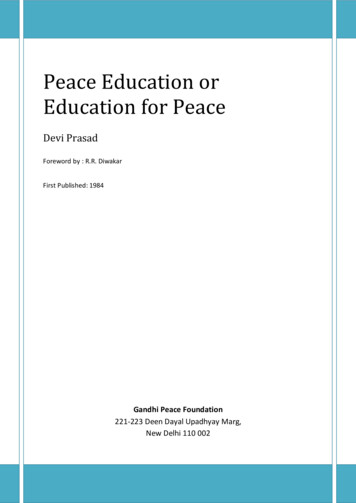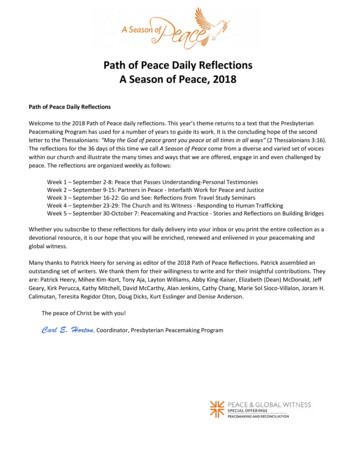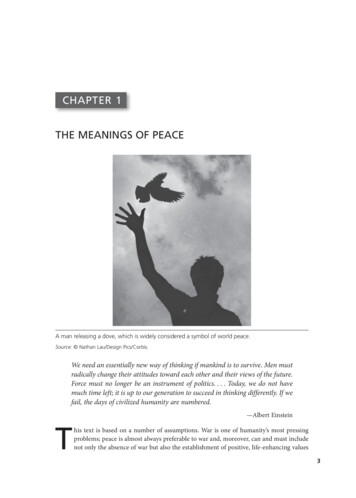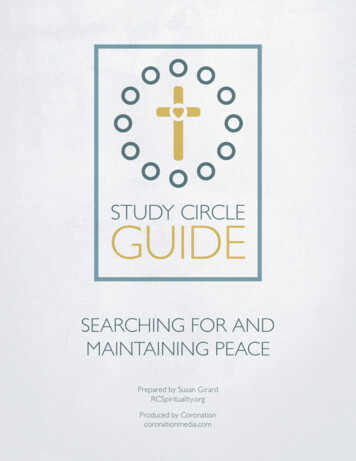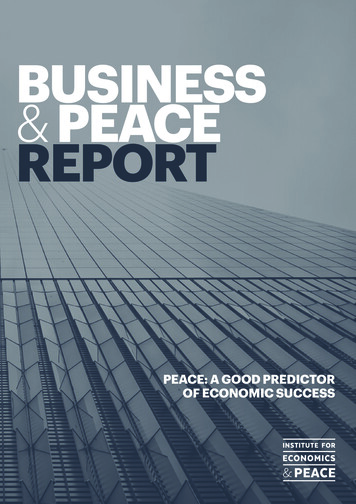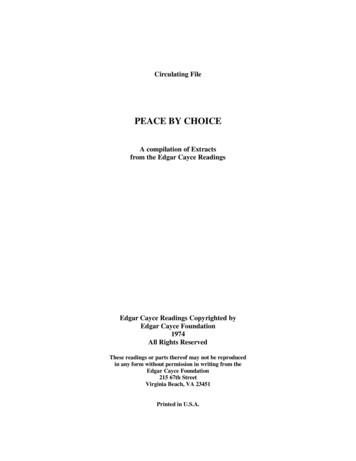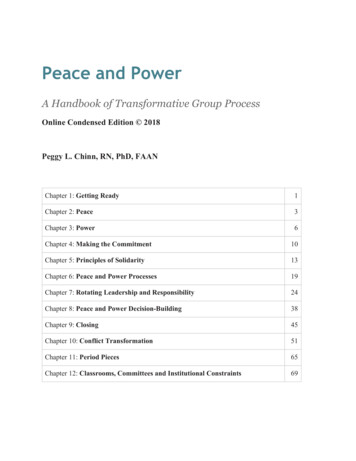
Transcription
Peace and PowerA Handbook of Transformative Group ProcessOnline Condensed Edition 2018Peggy L. Chinn, RN, PhD, FAANChapter 1: Getting Ready1Chapter 2: Peace3Chapter 3: Power6Chapter 4: Making the Commitment10Chapter 5: Principles of Solidarity13Chapter 6: Peace and Power Processes19Chapter 7: Rotating Leadership and Responsibility24Chapter 8: Peace and Power Decision-Building38Chapter 9: Closing45Chapter 10: Conflict Transformation51Chapter 11: Period Pieces65Chapter 12: Classrooms, Committees and Institutional Constraints69
CHAPTER 1Getting ReadyThe first challenge for any group considering Peace and Power is to figure out if this is foryou! Making a change to act and interact in cooperative ways that build strong communityrequires a commitment from everyone, challenges many practices that are habitual, and requiresnew learning for everyone. If you use this process, be aware that you, along with everyone inyour group, will be called upon to make significant personal changes.As you and your group consider using Peace and Power, it will be helpful for you to thinkabout the following questions. These questions provide a background from which you can clarifyyour shared intentions to bring about fundamental change. Do we agree about our purpose? It is common for members of a group to have differentideas about the group’s purpose. Identifying a simple statement that reflects a commonunderstanding of what you are all about is a good foundation for the work of Peace andPower. Do we seek to equalize the balance of power among everyone in the group? If people inyour group can answer “yes” to this question, Peace and Power processes are for you.This is easier said than done, and you will probably find that you will want to return tothis fundamental value as a group over and over as you work out how to make it a reality. How independent are we? If your group is part of a larger hierarchical structure (forexample, a school, corporation, or business) it will be more difficult to enact Peace andPower processes fully. It will not be impossible, but realize that you may have to makemajor adjustments (see Chapter 12.) If you are relatively independent of an externalhierarchical structure (for example, a community activist group, spiritual community, orintentional community), you will still be influenced by everyone’s habits in hierarchicalways of working together in a group. But you will be relatively free to create your ownprocesses consistent with Peace and Power. Are we all committed to spending time together? It is not possible to develop acommunity unless you spend time together. You may not be able to be together often, butyou need to have some regular and agreed-on time to be together, either in person orusing a virtual meeting room with both audio and video. Not everyone has to be presenteach time your group meets, but everyone needs to know when and where the groupmeets. Is everyone willing to pay attention to the group’s process? Peace and Power processesrequire taking time and turning attention to reflect on and discuss the group’s process.Bringing values and actions together is only possible if you take the time to discuss what1 2018 Peggy L Chinn
is happening in the process, and together carefully consider if your values and youractions indeed match. Do we seek meaningful change in ourselves and in the world at large? Peace andPower processes are designed to create practices that nurture and empower. These idealsare appealing to most people, but because they are rarely reflected in action, it is hard toanticipate what it will take to make them happen. A key to making this change happen isa shared vision that this is possible, and a shared intention to take the actions needed for it tohappen!2 2018 Peggy L Chinn
CHAPTER 2Peaceeace is intent, process, and outcome. The intention of Peace is the commitment tochosen values and actions that consistently bring about harmony, trust, and constructivesolutions to differences and dis agreements. The process of Peace is what you do together. Theoutcome of Peace is the actual experience of harmony, trust, and constructive solutions toproblems.The kind of Peace that this book is about requires conscious awareness of what happens in agroup and in a community. Peace requires that you know what you do as an individual when youinteract with others. Peace requires that your chosen values guide your actions. Peace is themeans and the end, the process and the product.The acronym that follows defines the idea of Peace. Each letter of the word PEACErepresents a commitment that guides the ways individuals can choose to relate to one anotherwithin the context of a group.P raxisE mpowermentA warenessC ooperationE volvementPRAXISPraxis is thoughtful reflection and action that occur in synchrony, in the direction oftransforming the world1. Most people have limited understanding of praxis because we live in atime when “knowing” and “doing” are rarely the same. In western cultures, the message “Do as Isay, not as I do” is all too familiar. When you choose to convey the message that “I know what Ido, and I do what I know,” you begin to live your values.Praxis is values made visible through deliberate action. Your actions, chosen to reflect values ofPeace and Power, become an ongoing cycle of constant renewal. As your actions are informed by your Charlene Eldridge and I adapted this definition of praxis from Pedagogy of the Oppressed by Paulo Freire (New York:The Seabury Press, 1970), p. 36. Our adapted definition emphasizes the synchronicity of thought and action.13 2018 Peggy L Chinn
awareness of values, your thinking and your ideas are shaped and changed by your experiences with thoseactions.EMPOWERMENTEmpowerment is growth of personal strength, power, and ability to enact one’s own will andlove for self in the context of love and respect for others. Empowerment is not self-indulgence,but rather a form of strength that comes from real solidarity with and among those who seekPeace. Empowerment grows not from an individual quest for personal strength and influence, butfrom active engagement with others whose values you share. Empowerment requires listeninginwardly to your own senses as well as listening intently and actively to others, consciouslytaking in and forming strength. Empowerment is not power over other people, other creatures, orthe earth. In fact, empowerment is only possible when individuals express respect and reverencefor all other forms of life and ground the energy of the Self as one with others and with the earth.AWARENESSAwareness is an active, growing knowledge of Self and others and the world in which youlive. This means tuning into the moment and valuing your own experience. This kind ofawareness sees beyond the present to integrate the past and the future. This is a vitaltransformation in a society that treats the knowing and experience of minority and marginalizedgroups—and of women—as abnormal or nonexistent. With awareness comes a consciousness ofdouble-speak, where what is defined as normal is really abnormal and what is defined as peace isreally war.COOPERATIONCooperation is an active commitment to group solidarity and group integrity. A group’scommitment to cooperation grows out of mutually defined values, where each individual’sviewpoint and abilities are honored equally. It means moving away from any action that exertspower over other individuals or groups. Rather, cooperation means encouraging everyone to usetheir abilities, ideas, and energy to join in creating a coordinated, cohesive whole. As individualsexcel in a skill or ability, their achievements are celebrated by all and shared with othersaccording to need and ability2.EVOLVEMENTEvolvement is a commitment to growth where change and transformation are conscious anddeliberate. Evolvement can be likened to the cycles of the moon where new and old, life and For a fun look at how to teach children and those who are children at heart the ways of cooperation, read Everyone Wins!Cooperative Games and Activities , by S. Luvmour andJ. Luvmour (Philadelphia: New Society Publishers, 2007).24 2018 Peggy L Chinn
death, and all phases are ultimately one. What remains constant is the cycle itself. As youexperience group processes based on PEACE, you are changed. A group changes ascircumstances shift, as individuals move in and out or become more or less involved, and aspurposes or activities change. Growth and transformations are valued and celebrated with eachnew cycle. You create your realities as you live them. There can be no mistakes, no disasters -only opportunities for re-creation.Peace Is Not . . .PEACE, when you embrace Peace and Power processes, is very different from typical wayswe have learned to “keep the peace.” It is important to recognize and move away from the oldways that actually create dis-ease and distrust. Peace is not: Letting things slide for the sake of friendshipDoing whatever is required to keep on good termsCriticizing people behind their backsBeing silent at a meeting only to rant and rave afterwardLetting things drift if they do not affect you personallyPlaying it safe in order to avoid confrontationManipulating someone to avoid open conflictCoercing someone to do what you wantHearing distortions of truth without refuting themIndulging another’s behavior when the behavior is destructiveWithholding information to protect someone elseHaving Good Intentions Is Not EnoughHaving the intent of PEACE is critical when you enter a group interaction; however, intentis not enough. Actions that flow from intent are essential. Examine how fully your actions flowwith your intent by asking questions like these: Do I know what I do, and do I do what I know? (Praxis) Am I expressing my own will in the context of love and respect for others?(Empowerment) Am I fully aware of others and myself, and do I bring these awarenesses to ourdiscussions? (Awareness) Do I honor and encourage everyone’s opinions, skills, and contributions? (Cooperation) Do I welcome practices that encourage growth and change for others, the group, andmyself? (Evolvement)5 2018 Peggy L Chinn
CHAPTER 3Powerower is the energy from which action arises. The kind of power that energizes PEACE isdifferent from power as it is used in the world at large.Power-over reflects a hierarchical ideal, where power is the capacity to impose one’s will onothers, accompanied by a willingness to apply negative sanctions against those who oppose thatwill. Power-over translates into a love of power, where the fact of having the power becomesmore important, more critical, than what that power is used for or what results from the use ofthat power. Once people have power-over and get caught up in it, they behave as if any measurethat is necessary to retain that power is justifiable.The kind of power required to create and live PEACE comes from the power of love. Whatis valued is the capacity to be in harmony with others and with the earth, and to join with othersin directing your collective energies toward a future you seek together. PEACE power reflects afeminist ideal where the focus shifts to chosen values that guide the exercise of power, and toconsidering what happens to people’s relationships when power is used.Although PEACE powers are familiar, you may not be accustomed to thinking of them aspower because of what you have experienced and learned in the traditions of the hierarchicalpower-over model. The PEACE powers are familiar because they are so central in the privateworld. Even though PEACE powers may seem idealistic when you read about them, when theybecome visible through action, they create dramatic changes. They become very real.In the Table that follows, you will see the contrasts between these two kinds of power.Power-Over PowersPEACE PowersThe power of Results emphasizesprograms, goals, or policies that achievedesired results. Achievement of the goalsjustifies the use of any means: “I don’t carehow you do it, just get the job done.”The power of Process emphasizes a freshperspective and freedom from rigid schedules.Goals, programs, and timetables are used astools, but are less important than the processitself.6 2018 Peggy L Chinn
The power of Tokenism3 – leaders givetoken gifts and token “promotions” to aselected few: “You deserve this specialrecognition.”The power of Appreciation - everyoneexpresses gratitude for the people around themand for actions that promote well-beingThe power of Prescription imposeschange by authority; vested interestsprescribe the out- come. The attitude ispaternalistic: “Do as I say, because I knowwhat is best for you.”The power of Letting Go encourages changeemerging out of awareness of collectiveintegrity; leadership inspires a balance betweenthe interests of each individual and the interestsof the group as a wholeThe power of Division emphasizescentralization, resulting in the hoarding ofknowledge and skills by the privileged few:“What they don’t know won’t hurt them.”The power of the Whole values the flow ofnew ideas, images, and energy from all,nurturing mutual help networks that are bothintimate and expansive. Practices that nurturegroup solidarity are regular habits of the groupThe power of Force invests power for oragainst others and is accomplished by awillingness to impose penalties andnegative sanctions. One individual makesdecisions on behalf of another individual orgroup of individuals: “Do it or else.”The power of Collectivity values the personalpower of each individual as integral to the wellbeing of the group. A group decision in whicheach individual has participated is viewed asmore viable than a decision made by any oneindividual and stronger than a decision made bya majority.The power of Hierarchy requires a linearchain of command, where multiple layersof responsibilities are subdivided intoseparate and discrete areas ofresponsibility: “I don’t make the decisions,I just work here.” Or, “The buck stopshere.”The power of Solidarity shares theresponsibility for decision making and foracting upon those decisions in a lateral network.This process values thoughtful deliberation andemphasizes the integration of variety within thegroup, while calling forth fundamental valuesembraced by the whole. The “Power of Tokenism” and the “Power of Appreciation” were added in consultation with3Adeline Falk-Rafael on November 26, 2015 (U.S. Thanksgiving Day)7 2018 Peggy L Chinn
The power of Command requires thatleaders be aggressive and that followers bepassive; leaders are assigned titles, status,and privilege (and higher pay!): “I will tellyou what to do.” And, “Tell me what todo.”The power of Sharing encourages leadership toshift according to talent, interest, ability, or skilland emphasizes the passing along of knowledgeand skills in order that all may developindividual talent.The power of Opposites polarizes issues.Individual preferences and insights aresubsumed by the requirement to makechoices “for or against.” Language reflectsthe values of good versus bad, right versuswrong: “If you aren’t with us, then you areagainst us.”The power of Integration views all aspects ofa situation in context. In the process of enactingself-volition, the individual integrates self-lovewith love for others and acts with respect foreach individual’s entitlement to self-volition.The power of Use encourages theexploitation of resources and people asnormal and acceptable: “If you don’t wantto work for what we are willing to pay,then quit. There are plenty of peoplestanding in line wanting this job.”The power of Nurturing views life andexperience as a resource to be cherished andrespected. The earth and all creatures areviewed as precious, deserving of respect andprotection, and integral to the well-being of all.The power of Accumulation viewsmaterial goods, resources, and dollars asthings to be used in one’s own self-interest,as well as items to gain privilege overothers: “I worked for it, I bought it, I ownit—and I deserve it.”The p ower of Distribution values materialresources (including food, land, space, money)as items to use for the benefit of all, to shareaccording to need. Material goods are valued asmeans, not as ends in and of themselves.The power of Causality relies ontechnology to conquer without regard forthe consequences that might be carried overinto the future. “Oh, the pill is causing youto retain fluid? Here, take another pill.This will make you lose fluid.”The power of Intuition senses which actionsto take based on the perceived totality of humanexperience. Although technology is consideredto be a resource, it is not elected for its ownsake or merely because it exists.The power of Expediency emphasizes theThe power of Consciousness considers long8 2018 Peggy L Chinn
immediate reward or easiest solution. “Oh,radioactive waste? Let’s just ship itsomewhere else or dump it in the sea.”range outcomes and ethical behaviors. Ethicsand morality are derived from values thatprotect life, growth, and peace, and that are thebasis for confronting destructive actions.The power of Xenophobia (the fear ofstrangers) rewards conformity andacquiescing to the values of those who holdthe balance of power. “Be a team player.Don’t make waves.”The power of Diversity encourages creativity,values alternative views, and encouragesflexibility. The expression of dissenting viewsis expected and encouraged. All points of vieware integrated into decisions.The power of Secrets relies on themystification of the process, agents, andchain of command. The agent who actuallyhas the power rarely implements decisionsor takes direct action, but assigns the dirtywork to someone else: “I’m just doing whatI was told.”The power of Responsibility focuses ondemystification of processes and insists onnaming and/or being the agent; open criticismand self- criticism are encouraged, motivated bylove and protection for the individual and thegroup.The power of Rules relies on policies andlaws to dictate what must be done and toprescribe punishments for breaking therules. A very few laws or rules arebeneficial, but runaway rule-makingcreates absurd contradictions. “Do itbecause the law requires it.”The power of Creativity takes into accountfundamental laws and rules that govern thesociety, but values actions and solutions createdfrom ingenuity and imagination. Actions arecreated to fit each situation, with the knowledgethat often there is a better way.The power of Fear focuses on imaginaryfuture disaster, and extreme actions aretaken to prevent that which is feared and tocontrol the behavior of others. “Let’s bombtheir cities: this will prevent terrorism.”The power of Trust focuses on buildinggenuine human relationships where honestexchanges of thoughts and ideas are followedby consistent action. If trust is broken, then therelationship is renegotiated.9 2018 Peggy L Chinn
CHAPTER 4Making the CommitmentPeace and Power begins with individuals in a group who consciously choose values consistentwith the PEACE values of Praxis, Empowerment, Awareness, Cooperation, and Evolvement,and values that are described as the PEACE powers. Here are examples of words and actionsarising from PEACE power values:A commitment to the Power of Process means: Giving yourself and everyone else in the group time to attend to a concern or issue thatexists for any individual. Letting decisions emerge gradually, realizing that very few decisions are urgent. Inviting everyone in the group to express their ideas or concerns during the discussion. Acknowledging the things that happen that are consistent with the group’s values.A commitment to the Power of Letting Go means: Acknowledging but setting aside your own interests, in order for others in the group toexpress their interests fully. Supporting others who are new, or learning something new, in their work of taking onsomething you are already skilled at doing. Expressing your misgivings or concerns about a situation in the group, but letting thesense of the group prevail when the group needs to move on to something else.A commitment to the Power of the Whole means: Placing your own individual needs and interests within the context of the group. Seeking w ays to do things together to equalize your power within the group.A commitment to the Power of Collectivity means: Taking into account the interests of every member of the group, including those who arenot present. Making sure that every concern is carefully integrated into every discussion and decision.A commitment to the Power of Solidarity means: Addressing conflict openly and constructively, and, in so doing, working actively tostrengthen the integrity of the group. Keeping the group’s principles of solidarity in conscious awareness as a basis for movingforward. Celebrating shared values and joys.10 2018 Peggy L Chinn
A commitment to the Power of Sharing means: Taking responsibility for leadership and tasks, including things you enjoy doing and cando well, as well as things you would rather not do but that need to be done. Encouraging others to join in passing skills and tasks along by assuming tasks fromothers.A commitment to the Power of Integration means: Listening actively and deliberately to every concern or idea that others bring to the group,and taking active steps to understand and act on others’ points of view. Taking actions that encourage bringing things together, rather than polarizing them intoopposing points of view .A commitment to the Power of Nurturing means: Treating others in ways that convey love and respect. Acknowledging that each individual’s experience has uniquely qualified her to be whereshe is at the present. Affirming and rejoicing in the knowledge that each person in the group has power to use,and power to choose how to use it. Using critical reflection (see Chapter 9) to bring forth the best for every individual andthe group.A commitment to the Power of Distribution means: Taking actions to overcome imbalances in personal material resources among groupmembers. Using resources that are available to the group - “Linda is willing to help us out of thistax mess” is a means, not an end. Working to make resources that are available accessible to all based on need, in theinterest of the development of the group and each individual.A commitment to the Power of Intuition means: Taking the time to think, feel, and experience the fullness of a situation. Taking a ctions that seem risky when your instinct tells you to go ahead. Paying attention to the intuition of others and taking their sense of things seriously.A commitment to the Power of Consciousness means: Talking about the values on which you are building your actions so that everyone can befully aware of your intentions. Exploring with others awareness of feelings, situations, responses, and meanings in your11 2018 Peggy L Chinn
experiences.A commitment to the Power of Diversity means: Carefully considering another point of view when your immediate response is to rejec
Peace and Power A Handbook of Transformative Group Process . The kind of Peace that this book is about requires conscious awareness of what happens in a group and in a community. Peace requires that you know what you do as an individual when you interact with others. Peace
